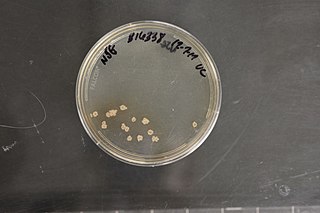
Micromonosporaceae is a family of bacteria of the class Actinomycetia. They are gram-positive, spore-forming soil organisms that form a true mycelium.
The Eubacteriales are an order of bacteria placed within the class Clostridia.

The Actinomycetia are a class of bacteria.

The Bifidobacteriaceae are the only family of bacteria in the order Bifidobacteriales. According to the 16S rRNA-based LTP release 106 published by 'The All-Species Living Tree' Project, the order Bifidobacteriales is a clade nested within the suborder Micrococcineae, also the genus Bifidobacterium is paraphyletic to the other genera within the family, i.e. the other genera are nested within Bifidobacterium.
The Coriobacteriales are an order of Actinomycetota.

Microbacteriaceae is a family of bacteria of the order Actinomycetales. They are Gram-positive soil organisms.
The Actinomycetaceae are a family of bacteria in the order Actinomycetales that contains the medically important genus Actinomyces. These organisms are closely related to the mycobacteria, but were originally classified as fungi because they were thought to be transitional forms between bacteria and fungi.

The Pseudonocardiaceae are a family of bacteria in the order Actinomycetales and the only member of the suborder Pseudonocardineae.

The Glycomycetaceae are a family of bacteria.
The Cryptosporangiaceae are the only family of the order Cryptosporangiales, which is a part of the phylum Actinomycetota.
Intrasporangiaceae is an actinomycete family. The family is named after the type genus Intrasporangium. The type species of Intrasporangium was originally thought to form endospores; however, the mycelium of this strain may bear intercalary vesicles that were originally identified as spores. No members of Intrasporangiaceae are known to form spores.
Dermabacteraceae is an Actinomycetota family.
Kytococcus is a genus of Actinomycetota bacteria.

The Acidimicrobiia are a class of Actinomycetota, in which three families, eight genera, and nine species have been described, Acidimicrobium ferrooxidans is the type species of the order.
The Coriobacteriia are a class of Gram-positive bacteria within the Actinomycetota phylum. Species within this group are nonsporulating, strict or facultative anaerobes that are capable of thriving in a diverse set of ecological niches. Gordonibacter species are the only members capable of motility by means of flagella within the class. Several species within the Coriobacteriia class have been implicated with human diseases that range in severity. Atopobium, Olsenella, and Cryptobacterium species have responsible for human oral infections including periodontitis, halitosis, and other endodontic infections. Eggerthella species have been associated with severe blood bacteraemia and ulcerative colitis.
The Dermacoccaceae is a family of bacteria placed within the order of Micrococcales. Bacteria af this familia are Gram-positive, non-spore-forming and non-motile. Dermacoccaceae bacteria occur on the skin.
The Dermatophilaceae is a Gram-positive family of bacteria placed within the order of Actinomycetales. Dermatophilaceae bacteria occur on animal and human skin and in fish guts.

The Micrococcales are an order of bacteria in the phylum Actinomycetota.
Balneolales is an order of bacteria.






